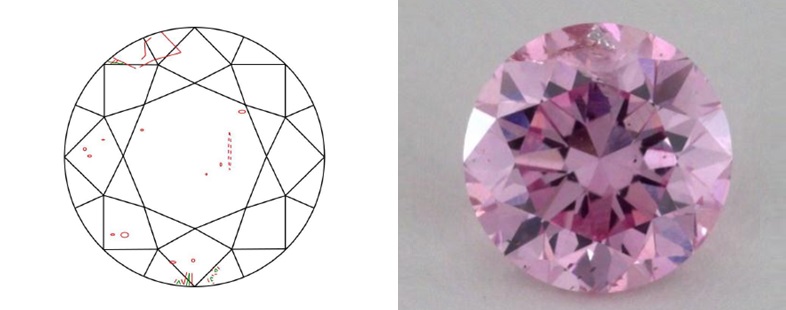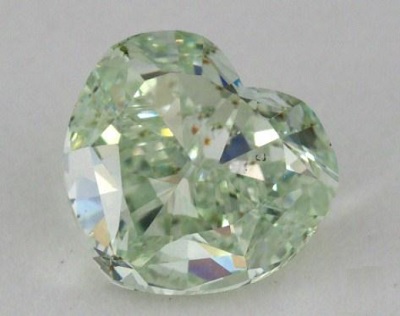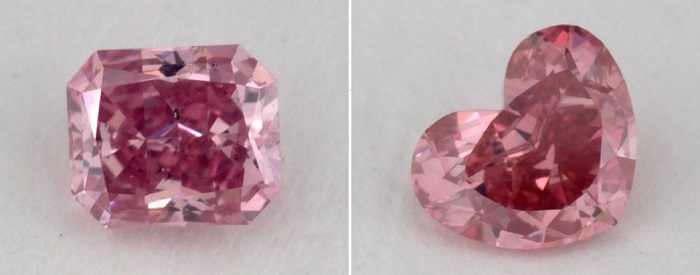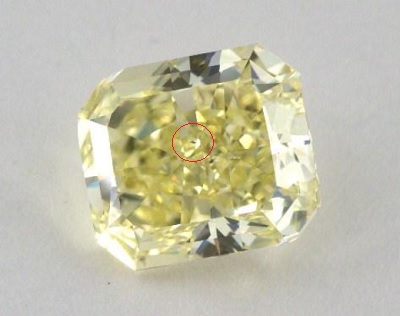Fancy Color Diamond Clarity
 Diamonds are created from violent and chaotic processes deep inside the earth. Under extreme pressure and temperature, it is common for natural microscopic characteristics to form in a rough diamond.
Diamonds are created from violent and chaotic processes deep inside the earth. Under extreme pressure and temperature, it is common for natural microscopic characteristics to form in a rough diamond.
Diamond clarity grading is used to determine the visibility of these imperfections and their overall impact on both durability and value of the stone.
In order to create a standardized method of categorizing these imperfections, gemologists classify these clarity characteristics as blemishes (external flaws) and inclusions (internal flaws). Together as a whole, they are termed as the clarity characteristics of a diamond.
Needless to say, diamonds that have the least or smallest imperfections are rarer in nature and are much more valuable. For example, flawless or internally flawless diamonds are extremely rare and command sky-high prices.
Yet, most of the imperfections found in diamonds with lower clarity grades are often microscopic and generally do not impact the stone’s beauty to the naked eye. In fact, the majority of commercial diamonds that are sold usually fall within these ranges because they are more affordable and offer better value.
The Clarity Scale And Individual Ratings Explained…

Flawless – Internally flawless (F – IF) – No inclusions under 10X magnification. The distinction between a flawless and an internally flawless rating is the presence of minor external blemishes.
Very, very slightly included (VVS1 – VVS2) – Minute inclusions which are difficult to observe under 10X even for trained graders.
Very slightly included (VS1 – VS2) – Small inclusions which are difficult to observe under 10X magnification. Diamonds are typically eye clean but may have visible inclusions at large carat sizes.
Slightly included (SI1 – SI2) – Inclusions that are easily detectable using a 10X magnification. Depending on a case by case basis, diamonds need to be examined to determine eye-cleanliness.
Included (I1 – I3) – Obvious inclusions that can usually be noticed by the unaided eye. In lower grades, inclusions pose severe durability issues and affect the brilliance of a diamond directly.
Click here for a more concise breakdown of clarity grades and chart comparisons…
Real Life Examples of Diamonds

This magnificent purplish pink emerald cut diamond has an SI1 grade that is eye-clean.

The color of inclusions may make some more visible than others as seen in this Argyle diamond.
In the labs, professional graders utilize a 10X magnification to identify the clarity characteristics of a diamond and they are frequently plotted on diagrams to map their corresponding locations. Much like our fingerprints, the clarity plot acts like a unique “birthmark” what is very useful the identification of a particular diamond.
Which Clarity Grade Should You Choose?
I get asked this question quite often and the truth is, there isn’t a straightforward answer as subjective factors come into play here. Just like how some people prefer certain colors over another, the choice of clarity is largely dependent on your personal tastes.
That said, if you cannot live knowing that the imperfections will affect your enjoyment of the diamond, you need to plan ahead and be prepared to spend a lot more money for a cleaner stone!
What Are Your Priorities? – Perhaps the most important factor comes from within you. Is clarity something that is symbolic to you in this purchase? I do know of some cultures whereby included diamonds aren’t fondly looked upon. On a much more personal scale, can you live with the diamond knowing that there are certain imperfections in it?
What is Available? – Circumstances might not always allow you to purchase a diamond with a certain clarity grade. For example, clarity grades higher than VS in colored diamonds are statistically rare. The fact is, the majority of mined colored diamonds have inclusions that place them within the Included (I) to Slightly Included (SI) ranges.

Green diamonds are so rare that you will be hard-pressed to find one with high clarity.
What Type of Inclusions Are Found in the Diamond? – Every individual mined diamond rough is inherently different and should be examined on its own merit. Also, depending on the nature and type of inclusions, a diamond with a higher clarity rating might not always be a better choice than one with a lower rating.
For example, a black crystal inclusion smack right in the middle of an SI1 diamond can be much more obvious than twinning wisps that are evenly distributed in an SI2 diamond.

Both of these diamonds are SI1 stones but one isn’t eye-clean (left – radiant) while the other is (right -heart).
What Purpose is the Purchase For? – Most consumers are happy with an “eye-clean” diamond whereby imperfections can only be observed under a 10X loupe. For people who buy diamonds for wearing, size and color are probably the first things a casual observer will notice. Do you think that someone will use a 10X loupe to examine your ring in public? It’s highly unlikely.
On the other hand, for people who are looking at diamonds as a form of investment, a diamond’s clarity is one of the aspects that determine rarity and should be a factor for consideration.
What Type of Diamond Shapes Are You Interested In? – Here’s a tidbit of advice that most people aren’t aware of. The cutting style of a diamond can help emphasize or hide flaws. In step cuts like emerald or asscher cuts, the larger facets and optical patterns can make flaws more visible to the naked eye. My recommendation is to select higher clarity grades (VS2 or better) for such stones.
Speaking broadly, brilliant cutting styles like rounds, ovals or cushions tend to conceal flaws due to their better sparkle and scintillation. Most diamonds in the slightly included ranges are eye-clean.
Size Does Matter in Clarity – The carat weight of a diamond has a direct influence on clarity as it is easier to see inclusions in larger stones. You need to be aware of the dangerous generalization that people mistakenly make. For example, you might be told that an SI1 or VS2 clarity grade is always free of eye visible inclusions. That’s not true. Much of it depends on the size of the diamond as well as the acuity of your eyesight.

This VS2 fancy yellow radiant cut might not be eye clean to some people.
The Importance of Images & Videos
Fancy color diamonds are a spectacle to watch and a collector’s dream to possess. Bear in mind that most colored rough stones are cut to maximizing value by retaining color and weight. While clarity is a component of the 4Cs, its significance in colored diamonds is often overshadowed by the more crucial aspects of color and carat size.
This has led to an influx of diamonds in the industry that are poorly cut and heavily compromised in clarity. You really need to be on your toes and make sure that you scrutinize every single detail of the stone prior to any purchase.
If you are in the market for a colored diamond, I recommend that you make JamesAllen.com your first stop. Their revolutionary video technology for showcasing a diamond reveals all the tiny details and helps you make educated purchasing decisions. If you need help or a 2nd opinion on any particular stone, feel free to drop me an email.

Leave A Comment